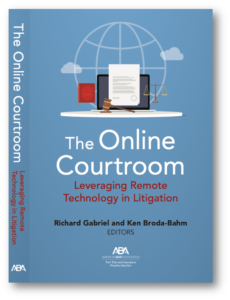By Dr. Ken Broda Bahm:

Even if the pandemic is finally over, and even if it is the last pandemic we will ever experience — and both of those seem pretty optimistic — it is still worthwhile to study and to learn from the unprecedented adaptations we have seen the U.S. trial system make in the last two years. Faced with the sudden need to avoid crowds and contact, the great ship of American courtroom practice was forced to execute a quick precision turn. Despite their generally conservative and tradition-bound natures, many courts rose to that challenge, moving swiftly to take meetings, conferences, hearings, testimony, bench trials, appeals, jury selections, and even full-blown jury trials online. And for every awkward and unsatisfying experience in the Zoom-space, there was also at least one complementary experience that turned out to be surprisingly effective, or even more accessible and efficient than its in-person counterpart.
Whether we will ever go through all of that again, it pays to learn from the experience and to assess which of these adaptations might become a useful part of our normal trial practice. There is a new book out that I helped to put together, and it does exactly that. Not to toot our own horn (but actually to bust out a full Coltrane solo) I’d like to talk a bit about that book. Entitled The Online Courtroom: Leveraging Remote Technology in Litigation (Gabriel & Broda Bahm, eds., 2024) it is published by the American Bar Association’s Tort Trial and Insurance Practice Section, and is a project edited with consultant Richard Gabriel and built on the contributions of the many distinguished members of the Online Courtroom Project. If the computer screen and camera are likely to play some role in your future trial practice, this book should be on your shelf. In this post, I’ll preview some of the main themes from the text.
The goal of the book is not to cheerlead for online trials, but rather to document the experience in many venues, and to provide a practical list of the ways remote legal proceedings should be conducted most effectively. Here are some of the highlights in the pages:
- Richard Gabriel begins the book by laying out the narrative of the American court system facing unexpected disruption and turning that into innovation.
- Justice (Ret.) Gary Hastings shares the results of several interviews he conducted with judges and courtroom personnel across the country, providing the view from the bench.
- Two Husch Blackwell attorneys, Lisa Oberg and Michael Sandgren, provide the attorneys’ perspective on the many practical challenges that go into making a case online, including managing the technology, maintaining attention, and handling documents.
- Consultant Alicia Aquino addresses the changes to witness testimony, including the removal of geographical limitations, as well as the need for better practices in document handling.
- Providing the view from the jury box, I provide a chapter sharing the experiences from actual and demonstration trials with jurors discussing the pros and cons in their own words.
- A team of consultants and trial technologists (Sarah Murray, Josh Splansky, Marc King and Ted Brooks) provide a systematic consideration of all of the perceived problems with the technical feasibility of online trials, and the extent to which each of them were or were not realized.
- On the legal side, Tulane law professor Michael Shammas and Sheppard Mullin attorney Michael Pressman provide a detailed examination of what we know so far on the legal permissibility of online litigation.
- Consultant Sarah Murray, with Marc King, addresses the question of whether online panels can be as representative, or more representative, than their in-person counterparts.
- For everyone who will participate in future Zoom calls, and that means everyone in and out of the field of law, consultant Lisa DeCaro’s chapter on credibly communicating in that environment should be required reading.
- Hoping that Zoom and its competitor companies might be listening, the final appendix also provides our list of custom features that a courtroom version of online conferencing software should include.
- In addition, a number of authors provided practical lists of best practices for other aspects of the trial process, including:
-
- Jury selection, and especially the use of online questionnaires (by consultant Jeff Frederick)
- Online arguments to the bench (by Wheeler Trigg O’Donnell attorney Theresa Wardon Benz)
- Technology implementation (by consultants Josh Splansky, Ted Brooks, Alicia Aquino, and Noah Wick)
- Witness and client meetings (by me)
- Managing jurors (by consultants Laura and Chris Dominic)
- Testifying (by attorney Jeffrey Kirschenbaum)
- Using exhibits (by consultant Noah Wick)
- Providing instructions (by Retired judge Gary Hastings)
- Deliberations (by consultant Karen Lisko)
-
To answer your unspoken question, yes, we did all of that in filling out all of the book’s 349 pages during the pandemic. Many of the authors have actually yet to meet in person. And these conditions provide a reminder that this is a topic that is very much still evolving. It is beginning to become clear, for example, that online hearings are here to stay, and that remote testimony is likely to become much more common. But how many of the other pandemic adaptations might be drawn upon again, or find their way into more normal courtroom practice? It will likely depend on how much we learn about how much we can adapt. On that, the online jury is still out.
____________________
Other Posts on Online Trials:
- Break the Backlog: The Durable Conclusions from the Online Courtroom Project
- Prepare for a Post-Pandemic (or Next-Pandemic) Courtroom: The Arizona Recommendations
- The Post-Pandemic Courtroom: Reflect on When Remote Court Still Makes Sense
Gabriel, Richard & Broda Bahm, Kenneth (2022). The Online Courtroom: Leveraging Remote Technology in Litigation. ABA Press, Tort Trial and Insurance Practice Section. URL: https://www.americanbar.org/products/inv/book/421699013/
Image credit: American Bar Association